If you’re running short of kibble and want to make up for it with raw food or you want to enhance the palatability and nutritional balance of your dog’s diet, mixing affordable kibble with appetizing raw food can seem like the right solution.
But can mixing raw food with kibble be dangerous to your dog?
Not really.
You can mix kibble with raw food as long as the kibble and the raw food are individually nutritious for the dog. Consuming both simultaneously won’t result in an upset stomach unless your dog has a delicate digestive system.
In this article, you’ll learn:
- The myths and confusion surrounding mixing kibble with raw food.
- How to mix raw dog food with dry dog food.
- A list of safe raw food items your dog can consume with kibble.
Canine nutrition, including how and what to feed your dog, can seem quite daunting and complicated. But it isn’t really.
So, if you want to know all about mixing dry dog food with raw, you’re in the right place.
Let’s get started!
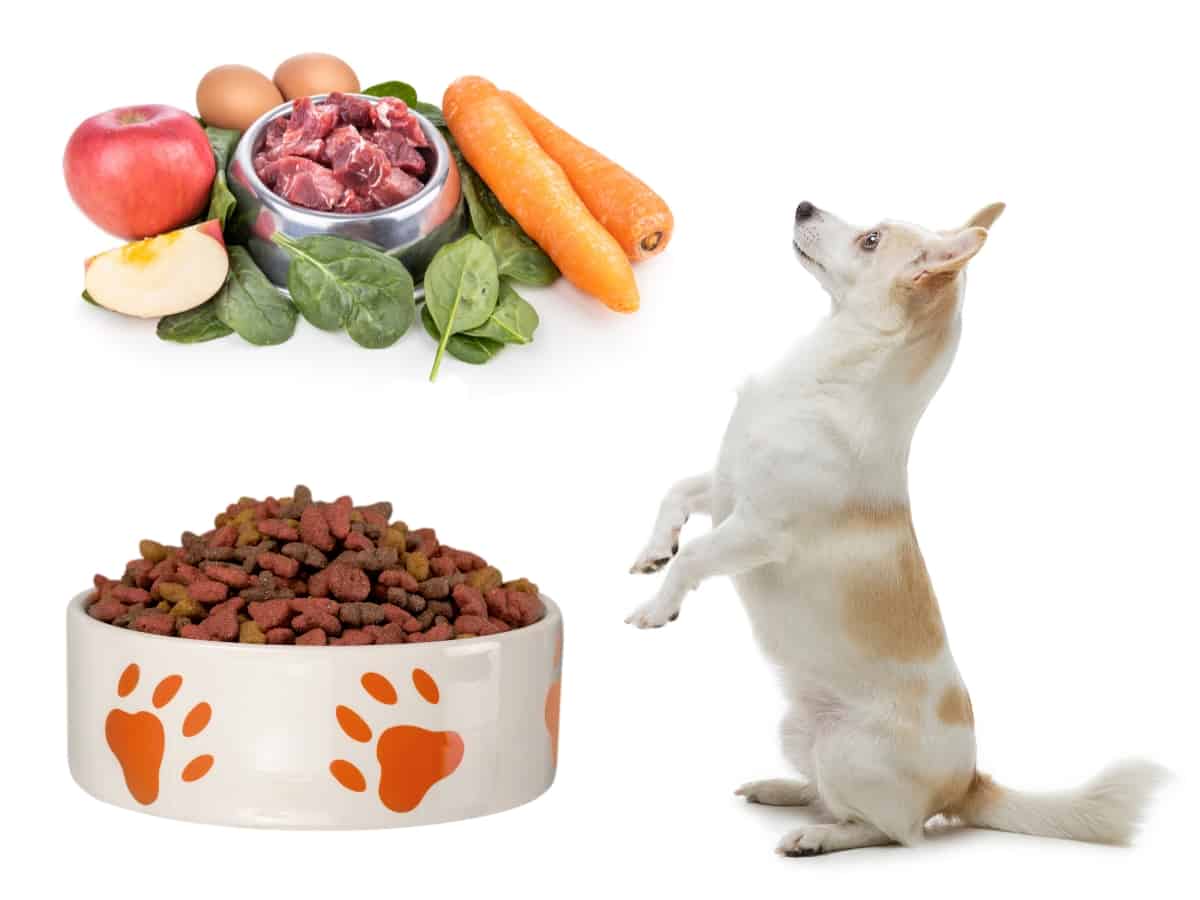
Can You Mix Kibble With Raw Food?
It is perfectly OK to feed a dog kibble and raw food together as long as both the kibble and the raw food are individually healthy and nutritious.
If the raw food is spoiled or the kibble doesn’t match your dog’s life stage or breed size, mixing it with an alternative food will not fix the problem.
Both kibble and raw dog food can individually cause problems if they are not the right fit for your dog or are not stored or prepared correctly. Before mixing kibble and raw food, you need to ask yourself the following questions:
- Is the raw food fresh? – The most serious issue with raw food is that it can go rancid pretty quickly.
- Is the raw food appropriate for my dog? – Sometimes, a raw food serving has more meat than a dog needs. Excessive intake of such food can cause weight gain.
- Is the kibble appropriate for my dog? – Kibble has to match your dog’s size and life stage – whether a puppy, adult, or senior dog.
- Is the kibble fresh enough? Kibble is generally easier to store and doesn’t go bad as quickly. Still, it is worth checking if the food is sufficiently fresh. In general, aim for 4-6 weeks for an opened package.
So, the mixing part isn’t the problem.
But when you mix two food items, you can overlook the shortcomings of one. It is like missing a stain on a shirt because you have a coat on.
The problem with mixing foods instead of outfits is that when you overlook the issues with one of the food types, you can put your dog’s health at risk if you fail to get the meal nutritionally balanced.
I like to follow the AAFCO’s nutritional guidelines for dogs. In a nutshell, dogs need:
- Protein – Between 18-22% (puppies need a minimum of 22%, adults 18%)
- Fat – Between 5-8% (growing pups need 8%, adults 5%)
- Vitamins
- Minerals
- Fiber
- Water
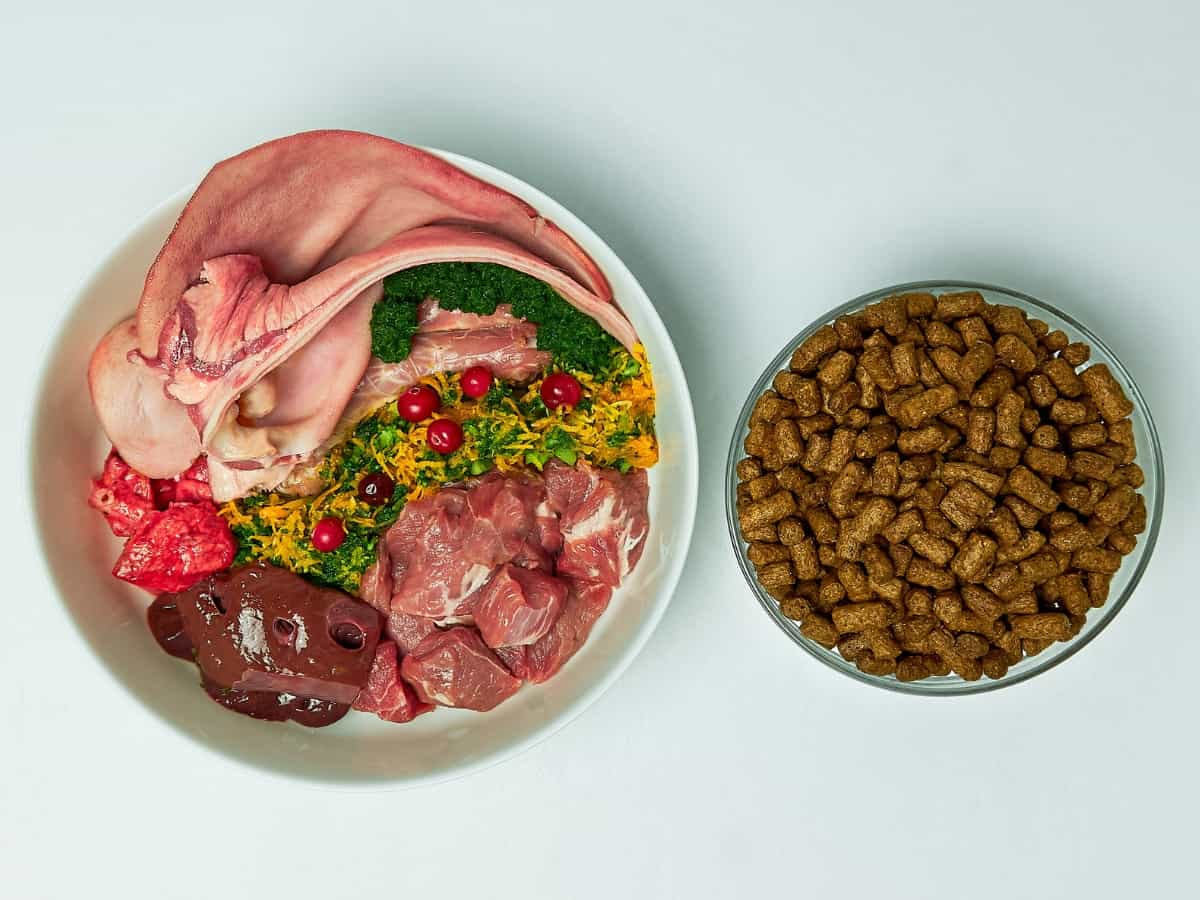
Unleashing the Power of a Hybrid Diet: The Kibble-Raw Fusion
In the quest for optimal canine nutrition, you may be exploring the idea of mixing kibble with raw foods. This approach, blending traditional and natural feeding methods, promises many benefits for our four-legged friends.
Let’s delve into the reasons why this combination might be the dietary change your dog needs.
- Nutritional Balance: Mixing kibble with raw food can create a more nutritionally diverse diet. Kibble often provides essential vitamins and minerals consistently, while raw food offers natural proteins and fats, leading to a well-rounded intake of nutrients.
- Enhanced Palatability: For dogs that may be disinterested in kibble alone, adding raw food can enhance the flavor and texture of their meals, making eating more enjoyable and encouraging better appetite in picky eaters.
- Health Benefits: Raw food typically contains natural enzymes and probiotics that benefit a dog’s digestive system. It also has fewer processed ingredients, which can lead to improved coat health, better dental hygiene, and overall vitality.
- Cost-Effectiveness: While raw diets are often more expensive than kibble, mixing the two can be a cost-effective way to provide the benefits of raw food without the high expense. This approach allows you to balance budget concerns with nutritional quality.
- Dietary Variety: A combination of kibble and raw food introduces different textures and flavors, which can prevent mealtime boredom. This variety can be especially beneficial for dogs that require long-term dietary management or have become accustomed to a single type of food.
- Customization for Specific Needs: You can adjust the ratio of kibble to raw food based on your pet’s specific health requirements, age, activity level, and dietary restrictions. This flexibility allows for a more personalized approach to meeting your dog’s nutritional needs.
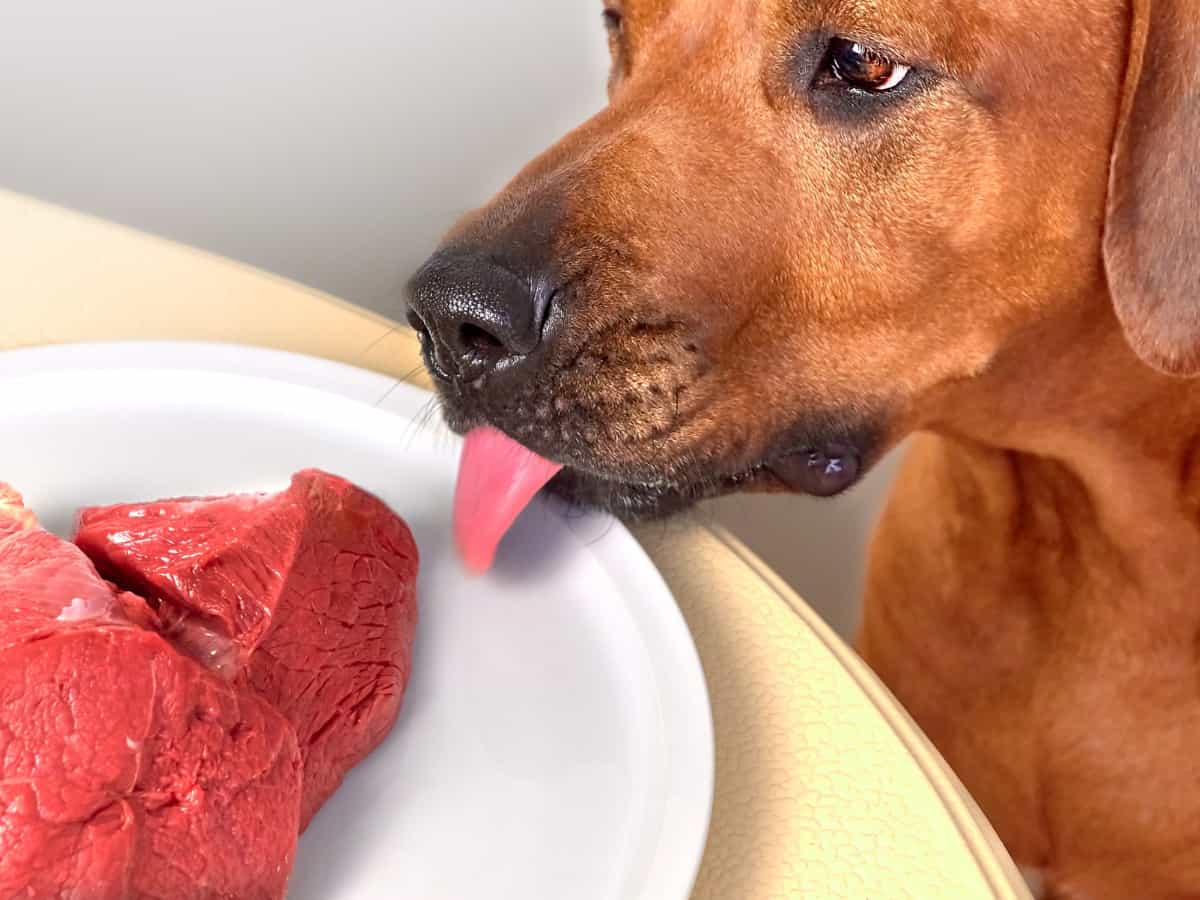
Should You Mix Kibble With Raw Food?
Adding toppers to kibble is not a novel concept. And plenty of those toppers, as well as additives, are homemade food items. However, dog owners can start getting anxious about mixing kibble with raw food.
Most myths about mixing kibble with raw arise from the dangers of consuming improperly stored raw food.
You should mix kibble with raw food as long as the raw food has been stored correctly and is free of contaminants.
If the raw food doesn’t pack too many calories, it can be used as an appetizing topper. If it is nutrient-rich, then it can replace a portion of the kibble.
The fact that raw dog food is far more appetizing than kibble makes mixing the two types of food beneficial for dog owners with kibble-aversive pets.
If your dog rejects kibble, you can mix it with alternative food items, including raw dog food. But don’t mix food just for the sake of mixing it.
Knowing the shortcomings of each type of food can help you determine what to mix with it.
The tables below will further elaborate on this.
| Problems With a Kibble-Only Diet | The Solution |
|---|---|
| The dog might not find it appetizing | Add aromatic meat or tuna as a topper |
| Low-quality kibble lacks vitamins and minerals | Cut up juicy veggies and mix them with the kibble |
| Kibble can upset your dog’s stomach | Replace half of it with a packaged serving of raw dog food |
| It is not moist enough | Add water to the kibble (or unsalted broth) |
| The kibble doesn’t have fiber | Add chopped broccoli to kibble to make the dog food fiber-rich |
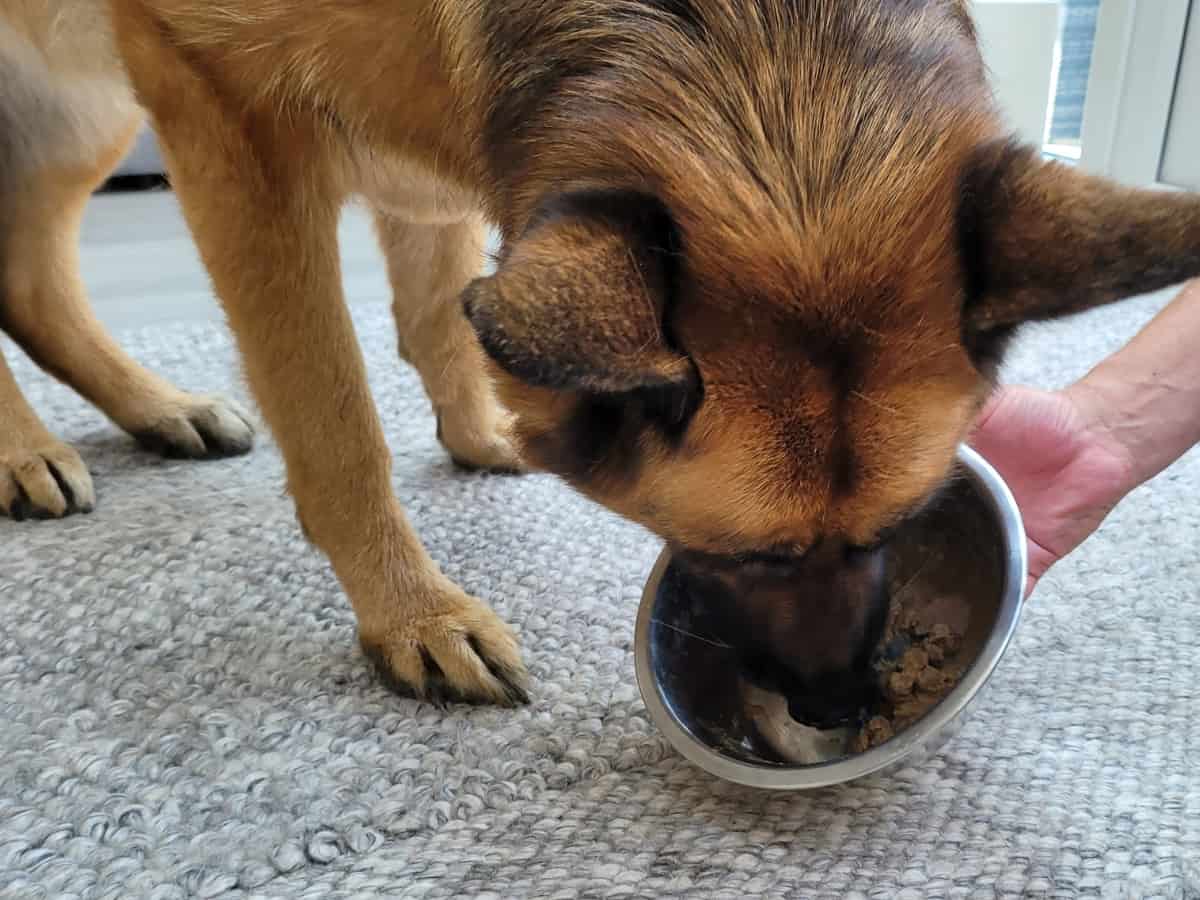
| Problems With a Raw-Food-Only Diet | The Solution |
|---|---|
| It can be expensive | Make kibble at least 3/4th of the dog food |
| Raw food can go bad easily | Mixing kibble won’t help. Get smaller quantities of raw food and follow food safety advice |
| It can pack too many calories | Minimize the raw food portion to reduce calories |
As you can see, raw food can offset the issues with kibble, but kibble doesn’t really help offset the contamination risk of raw food. It can, however, bring down the overall cost of feeding your dog.
Let’s explore how a mixed diet of raw and dry dog food can benefit your best friend.
Benefits of mixing kibble with raw food:
- Lower cost than a raw diet – A raw diet alone can be five times more expensive, while a mixed diet can cost as little as 10-15% over a kibble-only diet.
- More precise in macronutrients – You can tailor the mixed diet to deliver all the nutrients your dog needs.
- Can contain fiber and vitamins – Fiber and vitamins are essential for your dog’s healthy development.
- The food is more appetizing to your dog – Dogs that reject kibble can be persuaded to salivate over mixed food.
According to some studies, kibble co-mixed with fresh or raw food is considerably healthier than kibble alone.
However, studies are few and far between – and more research is warranted. According to this small study of eight dogs, raw and cooked diets compared to a dry food diet had greater nutrient digestibility and lower blood triglycerides.
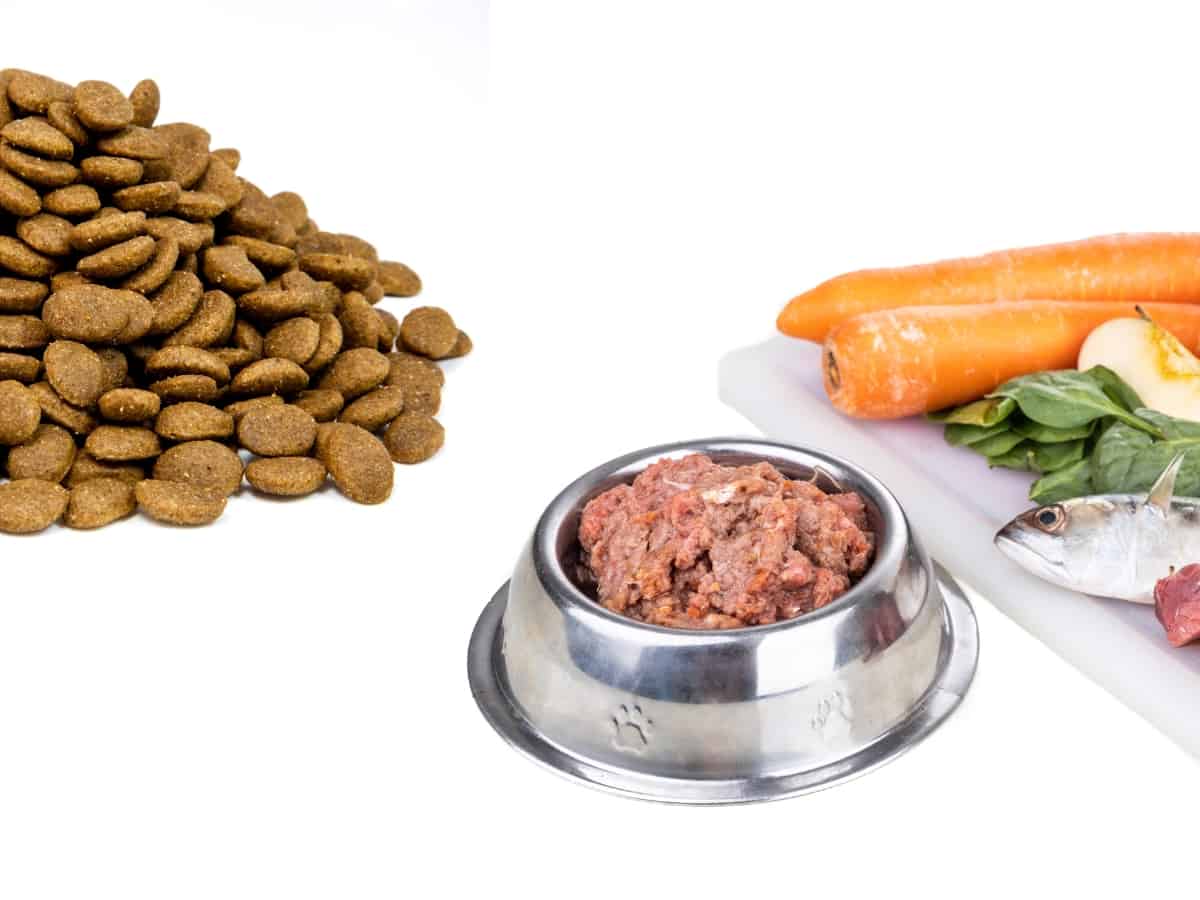
Mixing Kibble With Raw Food Myths
There are several myths about feeding a combination of dry and raw food. So, let’s un-muddy the waters and discover what science tells us!
- MYTH – The pH of the dog’s stomach is thrown off by kibble, making it difficult for the dog to digest raw food.
FACT – It’s challenging to find out what is in a dog’s stomach after eating food. Hence, there aren’t any studies comparing the pH of stomach acid between kibble vs. raw diets.
However, it is known that once food has entered the stomach, your pet’s GI tract does not distinguish between dry or raw foods.
In pet digestion, the GI tract only recognizes protein, fatty acids, carbs, and water and subsequently secretes acids, hormones, or alkaline compounds. No matter where these macronutrients come from, digestive enzymes readily break them down and obtain essential nutrients.
- MYTH – Raw and kibble digest at various rates, throwing the entire digestive system into chaos.
FACT – There are insufficient scientific studies on the different rates of canine stomach emptying, so the idea that kibble requires more time to digest is still only a theory.
One closely related study of dog breeds of different sizes fed a kibble diet showed that gastric emptying rate is related to the dog’s body weight. Scientists found that larger dogs retain food in the stomach longer and have a lower gastric emptying rate.
- MYTH – Mixing kibble and raw can cause harmful microorganisms to thrive in the gut.
FACT – Bacteria naturally grow in your dog’s gut, which can change and ultimately stabilize according to the diet your dog eats. While abrupt changes may cause an upset stomach, gradually transitioning kibble with raw is nothing your pet can’t handle.
Learn More About Mixing Kibble and Raw In This YouTube Video…
How To Mix Kibble With Raw Dog Food
To mix kibble with raw dog food, you need to source high-quality raw food items, portion them to be no more than 25% of the raw dog food, and mix them with a 75% portion of kibble. That means three parts of kibble for one part raw.
Here is what that looks like:
- Choose the type of raw dog food – This can be homemade raw or purchased frozen raw food.
- Get appropriate kibble – Use the dry food your dog is already accustomed to.
- Add one part of raw food – You can use a scoop or a measuring cup for this. Remember to follow raw pet food safety guidelines.
- Add three parts of kibble – The parts should be equivalent in size and, to some extent, weight as well.
- Mix and serve the food – You can add the raw food on top or combine it well throughout.
Which Raw Food Items Can You Mix With Kibble?
A significant part of the mixed diet is knowing what to mix with the kibble. I have an entire post on food items that can be mixed with kibble, but below are some examples of raw food that goes well with dry food.
- Red Meat – This is protein-rich and best for young adults and large-breed dogs.
- Chicken – Protein-rich and can be fatty in a healthy way. It is good for active dogs of all sizes. To keep calories down, feed minimal chicken skin.
- Tuna – A good source of protein, tuna can also be cost-effective.
- Veggies – Check with your vet whether the vegetables you want to mix into your dog’s diet benefit him. Excellent choices are carrots, pumpkin, broccoli, and green beans.
- Yogurt – It can improve your dog’s gut health. Yogurt must be Greek or organic, without xylitol.
- Eggs – An excellent protein source with the perfect balance of nutrients. Canines have eaten raw eggs for centuries.
- Commercial raw dog food – This is the safest (and the most expensive) option. You can get it according to your dog’s size and life stage. Look for a nutritional completeness claim on each label and not those marketed for “intermittent” or “supplemental” feeding.

The Half Raw Half Kibble Diet
Can You Feed a Dog Half Raw and Half Kibble?
If your dog is OK with 25% raw food mixed with his kibble, then you can try the half-and-half diet. However, the pros and cons of raw food (covered earlier) will be emphasized in the said diet.
You can feed a dog a half raw and half kibble diet if the raw food matches your dog’s nutritional requirements.
That means you need to consult a vet regarding the specific raw food. Some dogs might be sensitive to a mixed diet, especially if the mix is in a 1:1 ratio.
Can I Feed My Dog Kibble In The Morning and Raw at Night?
You can feed your dog kibble in the morning and raw at night, though it is better to do the opposite.
In either case, if the raw serving is enough hours apart from the kibble, even a dog with a sensitive stomach will be OK.
Alternative Feeding Options
If you’re not 100% sure about combining raw food with your dog’s kibble, you have the option of mixing it with home-cooked food.
Head to this article for greater insight into this hybrid feeding method: Can You Mix Kibble With Homemade Dog Food?
So, what do I feed my German Shepherd Willow?
My dog eats dry dog food (cold-pressed) with an added topping such as chicken, meat, tuna, mackerel, veggies, or yogurt. Willow has never eaten a fully raw diet.
However, I would be happy to try her with raw food if, for any reason, she becomes fussy with her food in old age.
FAQs
How can I ensure my dog gets a balanced diet when mixing kibble and raw food?
To balance a diet mixing kibble with raw food for your dog, consult a vet or canine nutritionist for proper nutrient proportions. Tailor the diet to your dog’s specific needs, considering age, breed, and health. Regularly monitor their health and adjust their diet as necessary to maintain optimal nutrition.
Can mixing kibble with raw food cause digestive issues in dogs?
Mixing kibble with raw food can sometimes lead to digestive issues in dogs, such as upset stomachs or irregular bowel movements. It’s important to introduce the new diet gradually and observe your dog’s reaction. Consult a veterinarian if any persistent digestive problems occur.
Are there specific types of kibble that work best with raw food?
When selecting kibble to mix with raw food, opt for high-quality, grain-free kibble that complements the nutritional profile of the raw diet. Look for kibble with minimal fillers and additives, and consider your dog’s specific dietary needs, such as age, size, and any health concerns.
Final Thoughts
You can mix kibble with raw dog food if both types are individually nutritious and fit for consumption. Mixing these two types of food is not the problem.
The problem arises from the raw ingredients being contaminated (which can happen with meat) or of low quality (which can happen with kibble).
If the raw food is safe for your dog and the kibble is of high quality, you can mix the two.





